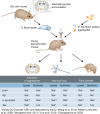Prion-like spread of protein aggregates in neurodegeneration
- PMID: 22566400
- PMCID: PMC3348110
- DOI: 10.1084/jem.20120741
Prion-like spread of protein aggregates in neurodegeneration
Abstract
Protein misfolding is common to most neurodegenerative diseases, including Alzheimer's and Parkinson's diseases. Recent work using animal models with intracellular α-synuclein and tau inclusions adds decisively to a growing body of evidence that misfolded protein aggregates can induce a self-perpetuating process that leads to amplification and spreading of pathological protein assemblies. When coupled with the progressive nature of neurodegeneration, recognition of such cell-to-cell aggregate spread suggests a unifying mechanism underlying the pathogenesis of these disorders.
Figures

Similar articles
-
Prion-like mechanisms in the pathogenesis of tauopathies and synucleinopathies.Curr Neurol Neurosci Rep. 2014 Nov;14(11):495. doi: 10.1007/s11910-014-0495-z. Curr Neurol Neurosci Rep. 2014. PMID: 25218483 Review.
-
Defining the Protein Seeds of Neurodegeneration using Real-Time Quaking-Induced Conversion Assays.Biomolecules. 2020 Aug 25;10(9):1233. doi: 10.3390/biom10091233. Biomolecules. 2020. PMID: 32854212 Free PMC article. Review.
-
Synthetic prions and other human neurodegenerative proteinopathies.Virus Res. 2015 Sep 2;207:25-37. doi: 10.1016/j.virusres.2014.10.020. Epub 2014 Oct 31. Virus Res. 2015. PMID: 25449570 Review.
-
Glycosaminoglycans and beta-amyloid, prion and tau peptides in neurodegenerative diseases.Peptides. 2002 Jul;23(7):1323-32. doi: 10.1016/s0196-9781(02)00068-2. Peptides. 2002. PMID: 12128089 Review.
-
Prions: generation and spread versus neurotoxicity.J Biol Chem. 2014 Jul 18;289(29):19862-8. doi: 10.1074/jbc.R114.568477. Epub 2014 May 23. J Biol Chem. 2014. PMID: 24860100 Free PMC article. Review.
Cited by
-
Context dependence of protein misfolding and structural strains in neurodegenerative diseases.Biopolymers. 2013 Nov;100(6):722-30. doi: 10.1002/bip.22283. Biopolymers. 2013. PMID: 23893572 Free PMC article.
-
The role of autophagy in neurodegenerative disease.Nat Med. 2013 Aug;19(8):983-97. doi: 10.1038/nm.3232. Epub 2013 Aug 6. Nat Med. 2013. PMID: 23921753 Review.
-
"Endothelial Antibody Factory" at the Blood Brain Barrier: Novel Approach to Therapy of Neurodegenerative Diseases.Pharmaceutics. 2022 Jul 6;14(7):1418. doi: 10.3390/pharmaceutics14071418. Pharmaceutics. 2022. PMID: 35890313 Free PMC article.
-
RAN proteins and RNA foci from antisense transcripts in C9ORF72 ALS and frontotemporal dementia.Proc Natl Acad Sci U S A. 2013 Dec 17;110(51):E4968-77. doi: 10.1073/pnas.1315438110. Epub 2013 Nov 18. Proc Natl Acad Sci U S A. 2013. PMID: 24248382 Free PMC article. Clinical Trial.
-
Cerebral vascular amyloid seeds drive amyloid β-protein fibril assembly with a distinct anti-parallel structure.Nat Commun. 2016 Nov 21;7:13527. doi: 10.1038/ncomms13527. Nat Commun. 2016. PMID: 27869115 Free PMC article.
References
Publication types
MeSH terms
Substances
Grants and funding
LinkOut - more resources
Full Text Sources
Other Literature Sources
Medical

